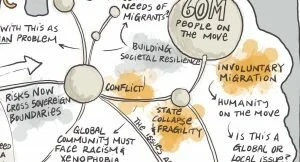Emergent Design

This piece was co-authored with Jodi Engelberg.
You can’t force someone to innovate, nor can you tell someone to learn. Demanding creativity usually results in the opposite, and expecting opposing parties to agree on a solution rarely ends well.
But innovation does happen, and somehow, people learn. Great ideas do come to people, and against odds, stakeholders align behind a common cause.
For those leading organizations or guiding change, the critical question is, how?
The difficulty is that many of the hoped for outcomes we have around innovation, creativity, and learning, for example, focus on properties we can’t directly influence. These things just emerge when they emerge: not on command. They have emergent properties. They are the “a-ha”, Eureka and magic moments. The culture, the attitude, the killer idea. While you can’t say in advance what “an innovation” is, or should be, you know it to be innovative – to be the product of innovation – when you see it.
We teach, but the objective is learning. It’s easy to plan what we will teach, but difficult to say when learning will happen, or indeed if it did.
Deliberate thought, design and planning is needed to achieve emergent results that are better than random. To innovate, we must create the environment, interactions, exposure and space in which innovation is most likely to happen. We call this emergent design. The emergent part happens at a few levels.
First, co-creating your design with the people you are designing for is the first level of emergence. This helps create the environment, process and structure necessary to influence the broader system. The second level, however, is being open and flexible to the changes, challenges and shifts that occur when people in the wider system are engaged. It is planning for the unknown, and knowing it when you see it.
Emergent Design is a mind-set, a philosophy and a set of methods for coaxing specific outcomes from systems; a method for focusing on what you can control to get results from a system you don’t control; because complete control is an illusion.
The Value Web has always strived to be emergent in our approach. Now we are trying to better describe what that means to us and how we do it. So, here’s a first draft of what we see as the common elements. We hope you will share your view and help develop a better understanding of this important practice.
Strategic Clarity & Purpose
A rigorous approach to objective-setting is required; everyone involved must know and agree on what goodness looks like, or at least how to recognize it when you see it. This is the “North Star” for the design – a clear direction that helps to keep everyone’s eye on the prize.
Model-Driven
Different types of emergence – learning, creativity – have patterns that allow it to happen time and again. People learn when the sum of their experiences are allowing to mix with new influences, and they are allowed to explore. New ideas are brought to life – both by individuals, and by groups – when we can see how to solve a problem, and build the desire to bring that solution to life. Having a model for the pattern allows you to shape your design – whether for an building layout, a strategy or a meeting – towards the outcome you are looking for.
Empathetic: Designed by and for Humans
At this stage in history, there is so much that we know about how humans work – or don’t – that we can easily increase the odds for success. Psychology, sociology, architecture, systems dynamics, social physics, economics; drawing simple rules from these vast bodies of knowledge allows us to experiment with the ways in which we meet to solve problems and grasp opportunities. Fire won’t ignite without oxygen; basic rules help us shape the physics of emergence.
These three elements, when properly mobilized and assembled in concert, create the conditions for intentional emergence – the spontaneous creation of unexpected outcomes which positively align with strategic objectives. Whether in an organization, a meeting, a campaign or an alliance, it involves tilting the system towards the highest contribution of all parties – of creating a combination of people that is more than the sum of its parts.
Over the next few months, members of The Value Web will continue to work together to detail our approach to, and understanding of, the practice of Emergent Design. We look to the broader community of practitioners to give insight and examples.
What practices and methods have you seen which could be seen as Emergent Design? What makes them so?

